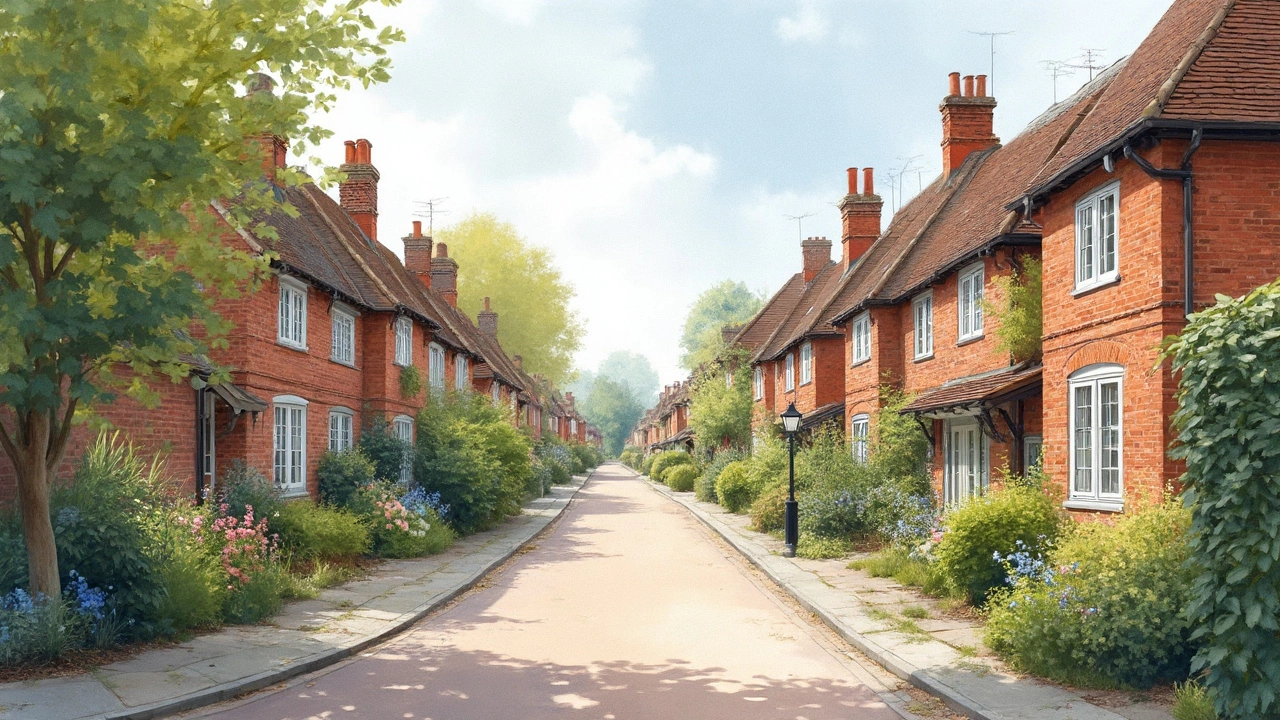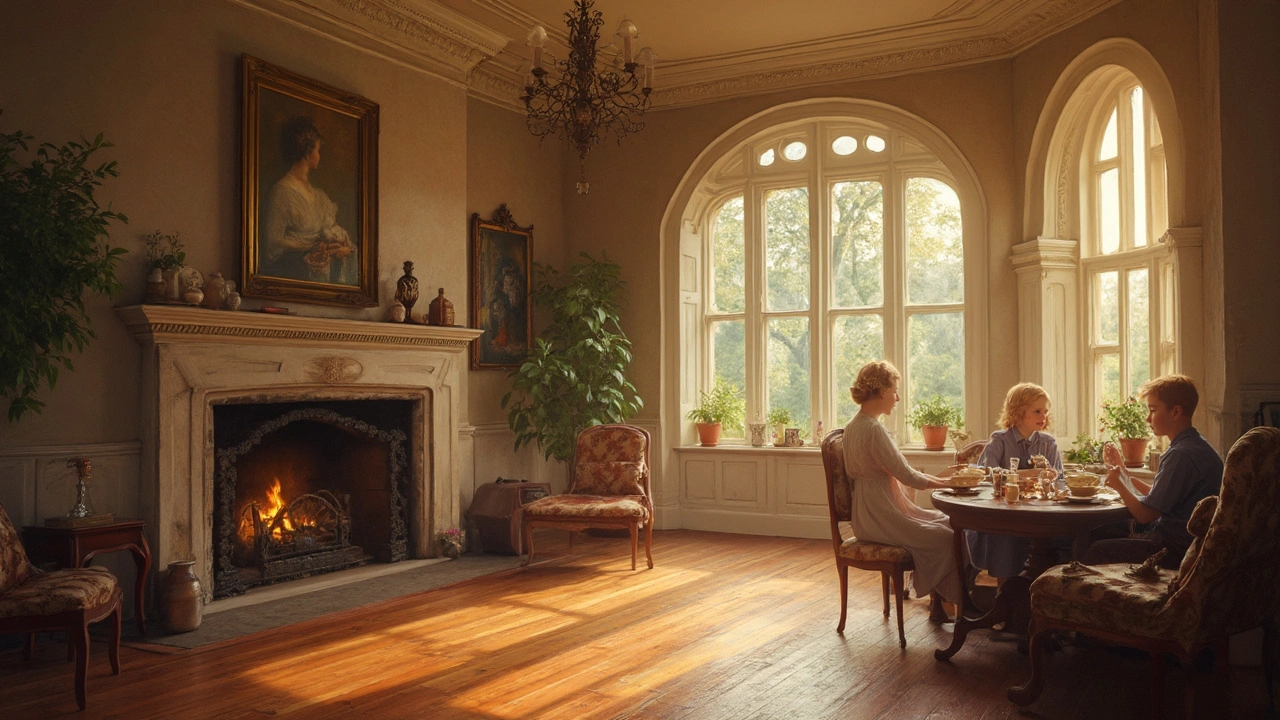Exploring Dutch Colonial Revival Architecture: Unique Features and Historic Charm
 Aug, 9 2025
Aug, 9 2025
If you wander past a house with a funny-shaped, barn-like roof that somehow looks both classic and a bit quirky, chances are you’ve just met a Dutch Colonial Revival. There’s something oddly satisfying about these homes, like they’ve got one sneaker in the past and the other firmly skipping into the present. The oddball beauty of the gambrel roof, those dormers peeking out, and all the little touches you might miss unless you’re really looking—these houses don’t just sit on a street corner, they tell you a story. And for all the styles that have come and gone, Dutch Colonial Revival still stirs up more than a bit of envy from anyone who loves history served with a twist.
The Roots and Rise of Dutch Colonial Revival
When most people think of Colonial architecture in the US, their minds jump to prim New England saltboxes, maybe a pillared mansion in Virginia. But the Dutch settlers who arrived around present-day New York and New Jersey in the 1600s had their own ideas about home. They weren’t building to show off, just trying to keep out drafty winters. Their houses were practical—steep, sweeping gambrel roofs meant there was space for the whole family, sometimes with livestock stowed underneath or up in the attic. Instead of stately brick or fine stone, a lot of these homes started as wood frames, simple but solid.
But Dutch Colonial Revival didn’t show its face until about two centuries later, right as America’s obsession with nostalgia was hitting its first high note. Between the 1890s and 1940s, as anything ‘colonial’ became all the rage, architects dug into old sketches and ruins. They weren’t trying to create exact replicas—it was more about capturing a spirit than building a copy. The handy gambrel roof was back, but now it showed off with elegant dormer windows instead of rough attic openings. Clapboard and brick made an appearance, but sometimes you’d spot a bit of stone, and interiors adopted modern touches in kitchen and bath layouts.
This style popped up everywhere—upstate New York, the leafy suburbs of Connecticut, even as far as California suburbs during the housing booms. And for anyone feeling out of place on a block of ho-hum bungalows, a Dutch Colonial Revival was pure personality in a sea of bland. The look was so charming that you could still stumble across mail-order house catalogs from the early 1900s offering kits seen as peak 'modern’ living—Dutch Colonial Revival plans included, shipped with all materials so a new owner could rise their own dream home, Sears-style.
And let’s be honest, that roof—gambrel, shaped a little like a bent knee—became iconic enough that most people wouldn’t know the word ‘gambrel,’ but they’d know the home by its shape. The revival took those old practical features and sprinkled in a bit of suburban fantasy, adding wide porches, beautiful entryways, and landscape gardens that were anything but rugged. Turns out, a few hundred years and a lot of clever builders can make a country’s mish-mash of ideas into something unforgettable.
Signature Features: What Makes It Dutch Colonial Revival?
If you’re trying to spot a Dutch Colonial Revival from the sidewalk, there’s one big feature you can’t miss: the gambrel roof. It’s got two slopes on each side—the upper is shallow, the lower is steep, kind of like a hat pulled low against the wind. This roof shape wasn’t just for looks, even with its cool profile. It's smart architecture. The steep lower slope gave early settlers more usable space in the upper floor, making it easier to tuck in crowded families or add roomy attics. Modern versions ran with that idea, only now you’re more likely to see kid bedrooms, dens, and even airy studios carved out under those eaves.
Another giveaway? Dormers. A Dutch Colonial Revival hardly feels complete without those tidy windows popping out of that barn-like roof. These aren’t just cute—they bring light where ceilings might otherwise loom a bit low, and they add curb appeal that’s tough to beat. As for exteriors, most originals used simple clapboard or brick, but the revival was happy to play around with stone or even shingle. The color palette usually leans toward classic whites, soft grays, or weathered earth tones, making these homes feel both grounded and trim.
Step inside, and many Dutch Colonial Revival homes keep it cozy and symmetrical. You might spot a central hallway flanked by living and dining rooms, often with a fireplace as the unofficial main actor on the ground floor. Kitchens shifted over the years—early ones might’ve been shady and utilitarian, while the 20th-century versions started showing off with breakfast nooks or open breakfast bars. Stairways are almost always right at the heart, and a lot of homes boast built-in cabinetry or quirky little shelves meant for anything from Grandma’s china to a year’s worth of jam jars.
Certain details pop up over and over—sidelights or fanlights at the front door, classic shutters, even bowed front umbrellas sometimes. Those wide, wraparound porches are strong contenders for the home’s MVP, giving you a reason to linger outside any time the weather’s halfway decent. Even gardens and landscaping echo the home’s simplicity, with English-style box hedges, Dutch-influenced tulip beds, or old-fashioned fruit trees making frequent cameos. Small or large, Dutch Colonial Revival houses just love to blend history with neighborly charm.

Why Dutch Colonial Revival Still Matters Today
So what’s the big deal with Dutch Colonial Revival now? These houses keep finding new fans, and not just with history buffs or lovers of vintage interiors. If you look at real estate listings in older neighborhoods—especially along the US East Coast, across the Midwest, and even scattered through Aussie suburbs—you’ll notice well-kept Dutch Colonials still post eye-watering prices. These homes exude enough character to make you forget the glass-and-chrome flash of ultra-modern design for a moment.
In today’s world of identical developments, people crave something that feels unique, rooted, and human. Those curved roofs, cozy porches, and the snug, practical layouts all remind buyers of an era when homes were built to last, not just impress. Dutch Colonial Revival is about comfort with a dash of drama. Families drawn to this style love that sense of shelter and tradition, but also appreciate the flexibility—attics and basements get reimagined as home offices, game rooms, or art studios without sacrificing old-school good bones.
Energy efficiency? Yep, even these historic homes can keep up. Thick walls, sensible window placements, and attic spaces make them easier to cool in summer or warm in winter with just a few modern tweaks. Many owners have retrofitted insulation, around original features, or even tucked solar panels in less noticeable areas, giving a classic look without sky-high utility bills. And with more folks working from home, there’s an added bonus—Dutch Colonial Revivals offer plenty of room for carving out office nooks or inviting creative corners, all filtered through a century-old lens.
Want to really lean into the old-meets-new vibe? Reclaimed wood works wonders in a kitchen, brass doorknobs or replica light fixtures turn an ordinary room into a time capsule, and keeping those big front porches—maybe with a hammock or two—means evening chats can outlast the setting sun. If you’re someone who likes your roots to show, but wants every excuse to invite friends over, these homes are hard to top.
Tips for Restoring, Renovating, or Embracing Dutch Colonial Revival
Thinking about buying, restoring, or just drooling over a Dutch Colonial Revival? There are a few tricks to doing it justice. First tip: don’t strip away what makes it special. Keep those gambrel roofs intact and resist the urge to swap out double-hung windows for something too modern. If trim or clapboard has to be replaced, look for wood in similar widths and textures—factory-made plastic will never pull off the same vibe.
If you’re aiming to restore, the good news is that many old-house resources stock just the right moldings, doorknobs, and fittings. Antique shops, salvage yards, even online auctions are gold mines. Small things—like refurbished porch lights or a period-correct mailbox—add huge doses of charm with little cost. When it comes to color, creamy whites, soft greens, or barn reds look at home, but it's worth studying period photos from the 1920s and 1930s for inspiration. Local historic societies often share paint guides or can pinpoint what’s true to the era for your region.
Practical upgrades are a must, but they don’t have to spoil the magic. Insulate behind original trim if you can. Update wiring carefully to keep plaster walls safe. Kitchens and baths can go classic or modern—just echo the old lines with round handles, panelled cabinets, or period tile. If you want your porch to be the envy of the block, swing chairs and a mix of old-fashioned planters will win fans with little effort. Leaky roofs? Don’t put it off. Gambrel shapes need proper flashing and guttering, and keeping up with maintenance means you’ll never curse that beautiful roof when storms blow in.
As with any older home, beware of hidden quirks—sometimes floorboards slope, foundations settle, and behind paneling you might discover a mouse’s private disco happening. But quirks aren’t always liabilities. Old beams can become instant conversation starters. If an original stone fireplace is tucked behind drywall, don’t rip it out—let it shine. If you’re making changes for the future, add extra outlets, build out attic storage, but honor the beauty of the details that have survived. And if you get stumped, there are forums, local preservationists, and even traveling craftsmen who make it their life’s work to revive Dutch Colonial beauties. You don’t have to go it alone.
For fans of design, a Dutch Colonial Revival is more than a style—it’s a living slice of an era that manages to celebrate craftsmanship and family comfort. Whether you’re hunting for your dream home or just stopping to admire one on your street, let those barn-shaped roofs spark some wonder. They’ve seen centuries of rain, sun, laughter, and life—and their story keeps going.